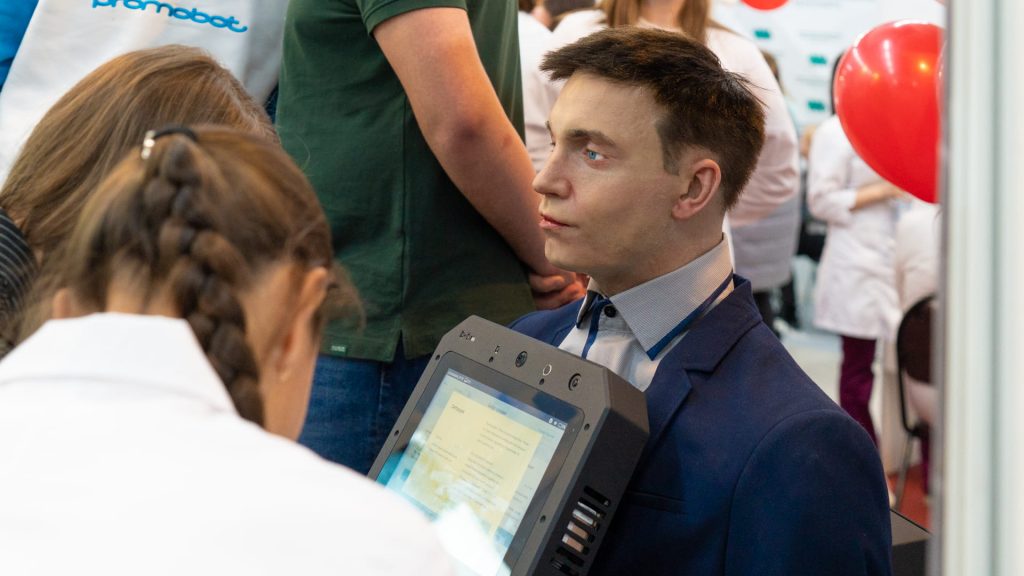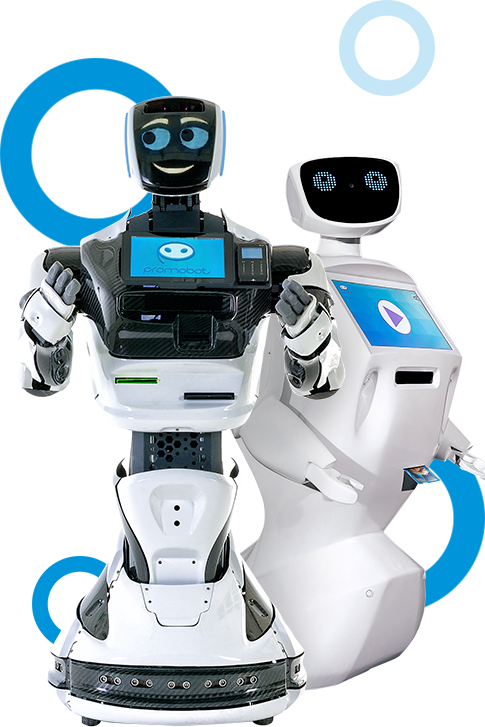Promobot’s functionality is reaching far beyond the known areas of work. Not only can they issue passes, meet guests in the office hall or conduct tours at the museum; robots slowly become an integral part of the educational process as well. Earlier Promobot could be implemented as an educational platform and training device for the students. Now, it is also possible to use the robot for student examination.
Andrey Baidarov, a director of IT and innovative development at Perm State Medical University, told us about the humanoid robot and how students use it in their learning process.

At the university, we implement simulation-based learning by recreating various patient-doctor interactions. Our goal is to ensure the simulation is as close to the reality as possible. For example, we have different equipment that provides the simulation of delivering children, resuscitation, etc. One of the most challenging aspects of training is the imitation of a simple visit to the doctor. Now, we have a robot companion Robo-C to help us with this task.
We called our robot Yuri, after Yuri Alexeevich Gagarin. The appearance of our robot is the Promobot’s standard one that is provided by Alexei Yuzhakov, the founder of Promobot.
The essential role
Each medical university graduate must receive accreditation in order to practice medicine. Accreditation is required for a student to confirm their qualification in the medical field to the accreditation council, which is responsible for the quality of medical education.
The idea of accreditation makes a lot of sense ― qualified institutions must provide qualified specialists. However, the fairness of such a process can sometimes be questioned.
Before Yuri, the only fair way to understand the competence of young specialists was a test. Admittedly, this method is far away from a realistic environment.
At one point, actors were used to provide more immersion during the exam; they had to simulate different symptoms and consequent illnesses. Here, we faced the human factor ― actors could forget things, simulate wrong symptoms, really do a lot of small things wrong.
Our perfect scenario is where we allow graduates to pass exams at real hospitals. It is, however, an enormous feat: more than 500 students graduate from our university alone. There is no such hospital with that capacity for examination. Because of that, the medicine simulation centers are often being created.
We decided that a humanoid robot is the most fitting solution for us. Robots are free from a lot of human mistakes: it never forgets anything, it constantly presents the uploaded scenarios on the same level of quality. If we upload 10 scenarios it will perform 10 scenarios and do so consistently well.
Now Yuri will be responsible for the accreditation process of the future medical specialists. It looks very similar to a human, can perform the symptoms and interact like a human patient. Robot interacts with students using one of the scenarios of work. Additionally, it can grade the student according to how correctly the answers and questions are presented, if the diagnosis is correct and if the student acts professionally. After the appointment the robot grades the appointment and that grade is as objective as it can possibly be.
The process of work
Robo-C analyzes the sequencing of questions asked by the student in accordance with clinical recommendations. Afterwards, it evaluates how accurately the diagnosis is made and what treatment is prescribed. Robot also stores every action and question during the session — students can review the information and improve their presentation. The obtained results and appointment history are sent to the professor for further review of the student’s performance. Afterwards, the teacher can decide if the student passed an exam or ask additional questions.
The most reliable simulator
At first, we decided to use Yuri just for the accreditation purposes, but that didn’t provide a sufficient workload for the robot, since accreditations do not occur all the time. We decided that since it can be used for examination it is also possible to further implement it in the learning process.
We are now planning to use Yuri to conduct small tests and course tasks. The professor has an exam credit and the students have to demonstrate that they know the course well. Therefore, the robot will be used to arrange these initial tests.
If you can’t answer the robot, how are you going to answer the professor?
Stress test
In large, Yuri is used to train clinical tasks that include not only a set of questions and their answers, but a lot more complex situations.
The visual identification of a patient is also important. You can’t conduct an appointment with actors or tests on the screen, they are not real people who have to be interacted with and treated.
For us, a lot of things in the robot itself allow us to constantly recreate unique situations. The robot may not hear something and ask the student to repeat it again, just like an actual patient who may not hear well and ask things several times.
Later on we are thinking of implementing more and more extraordinary scenarios. Patients often complain about the quality of communication even more so than the quality of treatment that they receive. For many people, the appointments are not so positive ― sometimes they put people under a lot of stress. In that regard, it is important for the doctor to control and guide the conversation properly. This is a hands-on experience that can be read about in books but will never be the same in real-life situations.
Robots for every school!
Each student at our university has to receive accreditation; that is about 500 students each year. We have 800 more students from other universities in the area, that is 1300 students every year just for our city alone.
Clearly Yuri can’t handle all of those students by itself, so we are thinking of ordering more companions for assistance.
Another thing that we keep in mind is future accreditation of practicing doctors which start taking place in 2021-2022. Now, thousands of doctors would be able to receive their accreditations through robots similar to Yuri.
Currently we are not just focused on our university. It is in our interest to expand the use of robotized solutions in medicine and doctors training. In that regard, it is a highly effective solution that we want to promote and inform the worldwide medical community about. Hopefully, humanoid robots will be soon present at every university around the globe.

